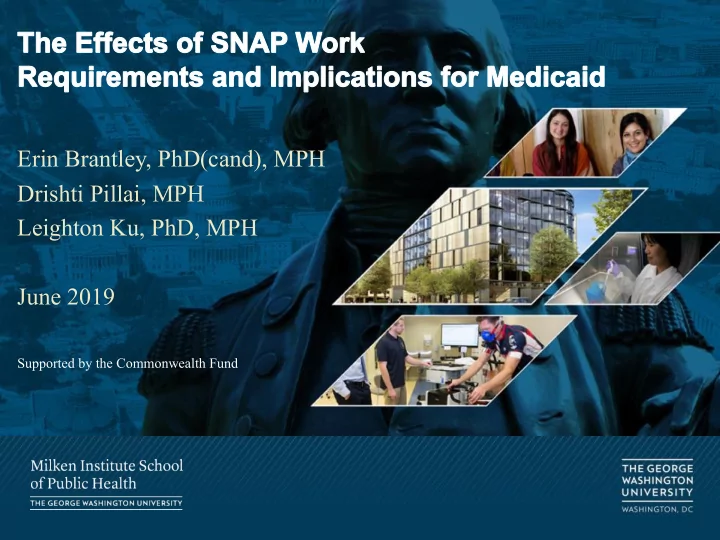

Erin Brantley, PhD(cand), MPH Drishti Pillai, MPH Leighton Ku, PhD, MPH June 2019 Supported by the Commonwealth Fund
Growing Reach of Work Requirements • Work requirements recently introduced in Medicaid (through state Section 1115 projects) • Trump administration is moving forward with expanding SNAP work requirements through regulatory changes • Proponents believe work requirements may prevent people who could work from being dependent on programs. • Prior research: benefit losses greatly outweigh possible employment improvements. (Han, 2018; Harris, 2019, Cochrane rev. 2018) • Can impacts be limited to the “able-bodied”? • What do work requirements mean in the context of disparate labor market outcomes for racial/ethnic groups?
SNAP and work requirements • SNAP (i.e., food stamps) is the largest federal food assistance program. 2007 2013 2018 Participants 47.6 million 40.4 million 26.4 million • Work req for non-disabled, childless adults ages 18-49 (so- called able-bodied adults without dependents, ABAWDs) § Exemptions include medically unfit to work. • ABAWDs who do not meet the requirement can only receive SNAP for 3 of every 36 months • States can choose to waive the work requirement due to high unemployment
Percentage of low-income adults living in areas with work requirement, 2012-2017 70% 60% 50% 40% 30% 20% 10% 0% 2012 2013 2014 2015 2016 2017 White Black Hispanic Note: weighted estimates. Sources: American Community Survey; work requirement policies from the Food and Nutrition Service (FNS).
Methods • American Community Survey (ACS) data 2012-2017 • Quarterly work req info from Food & Nutrition Service • Outcome: SNAP participation in the previous 12 months • Work requirement variable: 2-year average of each Public Use Micro Area (PUMA) subject to a work requirement • Stratified analyses with two groups of low-income (<200% FPL) adults ages 18 to 49 with no children <18: (1) ABAWDS: non-disabled adults (2) Disabled adults (excluding SSI) • Estimated interaction of work requirements and race and ethnicity for ABAWDs
Methods (2) • Linear probability models g ipt =β 1 WR pt + β 2 X it + β 3 Mcaid + β 4 UR pt + β 5 UR p(t-1) + β 6 Pov pt + α p + δ t + e ipt • Covariates: – Two-way (year and PUMA) fixed effects – PUMA-year unemployment rate; lagged unemployment rate – PUMA-year poverty rate – State-year Medicaid eligibility for childless adults – Individual demographic covariates • Weighted and adjusted for clustering by PUMA
Results: Impact of work reqs on low- income ABAWDs and Disabled adults ABAWDs Disabled Work requirement -0.029*** -0.044*** 0.008*** 0.036*** Medicaid eligibility 0.004*** 0003* Unemployment rate 0.002*** 0.004** Lagged unemployment 0.001** 0.002 Poverty rate 416,692 55,430 Observations * p<0.10 **p<0.05 ***p<0.01
Results (2): Magnitude of participation decline ABAWDs Disabled Work requirement coefficient -0.029*** -0.044*** .15 .40 Mean SNAP participation 19% 11% Implied % decline in participation
Results (3): Work requirements and race/ethnicity AABAWDs Mean SNAP Implied % (n=416,692) Participation decline 0.12 16% Main effect (White) -0.019*** Interaction of WR and: -0.050*** 0.28 25% Black 0.013* 0.06 11% Asian -0.009 0.16 17% Hispanic -0.011 0.19 16% Other race * p<0.10 **p<0.05 ***p<0.01
Limitations • ACS data § Ambiguous timing of SNAP outcome § Under-reporting of food stamps • Waiver data § Approvals for waivers of work requirements may not correspond precisely to implementation (should bias to zero) • Identification strategy § Possible time-varying characteristics within PUMAs not accounted for by our covariates
Related Presentation • “The Effects of SNAP Work Requirements in Reducing Participation and Benefits” Tuesday 6/4, 12 – 1:30, Rm 152B • Presents analyses of SNAP administrative data, rather than ACS data. • More precise estimates of level of participation effects, but less information about characteristics of those affected. • Indicates that more than a third of ABAWDs lose benefits.
Discussion • Evidence for harm of work requirements is substantial • There is little evidence that work requirements improve employment outcomes (Han 2018, Cochrane review 2018) • Many people with health limitations are likely to lose coverage § Individuals may have health problems that make work less likely, but not qualify for an exemption § May face paperwork barriers • Unemployment much higher for black than white workers § Discrimination against African Americans in hiring continues (Quillian, et al. 2018)
Thank you! contact: ebrantley@gwu.edu @erinjbrantley
References • Gibson, M., Thomson, H., Banas, K., Lutje, V., McKee, M. J., Martin, S. P., … Bond, L. (2018). Welfare‐to‐work interventions and their effects on the mental and physical health of lone parents and their children. In The Cochrane Library . https://doi.org/10.1002/14651858.CD009820.pub3 • Han, J. (2018). SNAP Expansions and Participation in Government Safety Net Programs (SSRN Scholarly Paper No. ID 3296547). Retrieved from Social Science Research Network website: https://papers.ssrn.com/abstract=3296547 • Harris, T. F. (2019). Do SNAP Work Requirements Work? Upjohn Institute. https://doi.org/10.17848/wp19-297 • Quillian, L., Pager, D., Hexel, O., & Midtbøen, A. H. (2017). Meta-analysis of field experiments shows no change in racial discrimination in hiring over time. Proceedings of the National Academy of Sciences , 114 (41), 10870–10875.
Recommend
More recommend